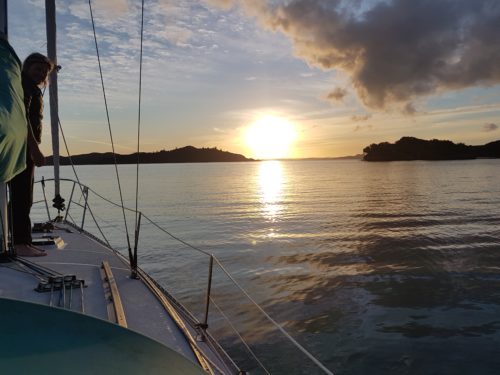To anchor successfully you need to make good decisions on selecting an anchorage and know how to set your anchor. Your goal is to have the anchor hold for your desired amount of time and be able to pick your anchor up safely and cleanly when departing.
Selecting an anchorage
Factors to be considered when selecting an anchorage:
- Depth: Does the anchorage offer sufficient depth at low tide for your vessel? Will there be sufficient water under the keel at low water? On an incoming tide, will you have sufficient rode and chain to lay an anchor correctly – with sufficient rode and chain laid along the sea bed?
- Wind forecast direction: Ideally you are seeking an anchorage with an offshore breeze where you are protected from the wind by the land. Check the forecast for at least the next 24 hours during your intended stay there.
- Anchor Watch: If the conditions are stormy or forecast to change significantly during the night you may need to keep an anchor watch and have crew maintain watch through the night ready to start the engine in case the anchor drags.
- Ground holding: The material on the seafloor tells you how well your anchor is likely to hold
- Mud – ideal as it allows the anchor to embed in the mud.
- Sand – can be difficult to hold if the sand is soft.
- Kelp/Seagrass – typically not ideal seafloor as the anchor tends to skid across the kelp without anything to hook onto/embed in and can make bringing up the anchor especially messy.
- Rocky –Consider rigging a trip line to give an alternative method of recovery if it gets stuck.

- Tide: You need to ensure you will have adequate depth under the keel of your boat at low tide for your anchorage. Similarly, you need to ensure you have adequate warp and chain on your anchor to allow for high tide at your anchorage.
- Exposure to passing craft: You may have found a beautiful anchorage however it may quickly become unpleasant if it is near a channel/common passage for passing craft at speed. The continual wake from passing craft, particularly those passing at speed, can quickly disrupt a tranquil bay.
- Room at the anchorage: There must be ample room to swing on your anchor. When you enter an anchorage, you are responsible for not swinging into boats that anchored before you.
Potential hazards
-
- Moorings: It is extremely easy to foul an anchor on mooring tackle and can be difficult to untangle. Each mooring will likely have a significant amount of ground tackle, chain, and lead rope to the buoy around it so you should leave ample room between you and it. (Anchoring in the tightly packed mooring areas in the Bay of Islands is not recommended).
- Reefs: do not anchor on or too close to a reef
- Cables: do not anchor over a cable, they are clearly marked on your charts.
- Ferry channels: You must avoid shipping channels and ferry lanes unless it is an emergency
TIP: When at anchor the boat should point into the wind most of the time. If it is not you are either in a cross-current or DRIFTING.
Setting the anchor
Manually
- Prepare the anchor and chain to pay out. If using warp, overhaul the line.
- Identify where you would like to anchor
- Approach the site slowly – with appropriate boat speed. Look at how other yachts are lying on anchor and try to line up with them. This will be into the wind or the tide, whichever one is stronger.
- Stop forward of the spot you would like the boat to be in. Ease the anchor down hand over hand. Take extreme care with your hands and fingers. Don’t just throw all the chain over in a big mess, or it will stay a mess under water and not hold the boat.
- If the wind doesn’t move the boat back, reverse slowly as the anchor is being paid out. You want to lay the chain flat on the sea bottom.
- Pay out the required amount of warp as you continue to go slowly astern. When the rope makes an angle of about 30 degrees to the water’s surface, stop letting the rode out.
- Take a turn around the cleat to try to hold the boat.
- When the anchor digs into the seafloor and holds you should feel the boat connect with the chain. The boat will stop moving astern and the anchor may pull the boat forward.
- Set the anchor. Put the vessel in reverse and slowly throttle up, as necessary to confirm the holding for the anticipated conditions.
- Tie off the anchor rode and choose landmarks to confirm continued holding.
Anchor Etiquette
When communicating between helmsperson and crew stay calm and respectful and use hand signals to communicate.
- Respect those boats that were at the anchorage before you. If you anchored after them it is your duty to move if you become/swing too close.
- Be considerate of other boats in the bay:
- Be conscious of loud noise from your boat, loud music, yelling etc
- Be conscious of your dinghy wake – it too can be disruptive to other vessels
- Only board other vessels when invited
Anchoring Terms
- Chain: The first thing connected to the anchor should be its chain. You need at least the length of the boat of chain on the bottom when the anchor is laid. Lay the anchor with enough chain on the bottom so that even with the rise and fall of the tide, the boat is swinging on the chain on the bottom and not the anchor itself.
- Warp: the rope that connects to the anchor chain. You may want to put different coloured cable ties along your chain and warp, so you know how much you have laid out. Also known as the anchor cable.
- Rode: the combination of chain and warps attached to the anchor
- Scope: the ratio of anchor rode to water depth. The ideal scope is 7:1, and 4:1 is sufficient for anchoring for a short time. 5:1 works well with an all-chain rode. Increasing the scope increases the holding. In an area with a greater tidal range and/or harsher weather conditions, you will need to increase the scope for the conditions. In a crowded anchorage, you may need to reduce the scope so the boat does not swing into anything.






